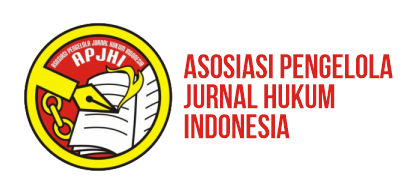Pembatasan Perubahan Bentuk Negara Kesatuan dalam Undang-Undang Dasar 1945 dalam Perspektif Constitution Making
DOI:
https://doi.org/10.31078/jk1543Keywords:
Pembatasan Perubahan Bentuk NKRI, Constitution Making, Perubahan UUD 1945Abstract
Tulisan ini diarahkan untuk melihat tentang Pembatasan Perubahan atas Bentuk Negara Kesatuan Indonesia yang dituangkan dalam Pasal 37 Ayat (5) UUD 1945 sebagai bagian dari konsep pembentukan suatu konstitusi (constitution making) yang pada prosesnya tetap mempertahankan Bentuk Negara Kesatuan Republik Indonesia dan juga menetapkan sejak awal dalam Bab tentang Perubahan UUD 1945 dalam Pasal 5-nya untuk nantinya manakala ada perubahan haruslah mempertahankan Bentuk Negara Kesatuan Republik Indonesia. Hal ini tentu menjadi menarik jika dikaitkan dengan makna constitution making pembentukan konstitusi yang baik haruslah mempunyai tujuan salah satunya untuk semakin memperkuat persatuan nasional. Disisi tahapannya bahwa sebagai materi muatan perubahan UUD 1945, ternyata bahwa Bentuk Negara Kesatuan Republik Indonesia tetap dipertahankan dalam proses perubahan (agenda setting) melalui Kesepakatan Dasar dalam hal perubahan UUD 1945. Metodologi penelitian yang digunakan dalam penelitian ini adalah yuridis normatif dengan pendekatan sejarah hukum. Hasil penelitian dari tulisan ini dapat dilihat bahwa pembatasan perubahan bentuk NKRI terdapat tiga (3) aspek yang berkaitan dengan masalah tahapan atau proses perubahan UUD 1945 sebagai constitution making. Aspek pertama adalah bahwa pembatasan perubahan bentuk NKRI yang termuat dalam Kesepakatan Dasar adalah sebagai elemn-elemen atau hal yang dipertahankan dalam tahapan agenda setting. Aspek kedua adalah menjaga kontinuitas hukum dari bentuk NKRI yang sudah ada dalam UUD 1945 sebelum perubahan. Aspek ketiga adalah bahwa terhadap dampak atau konsekuensi hukumnya, bahwa Pasal 37 Ayat (5) UUD 1945 akan menempatkan bentuk NKRI sebagai elemen atau hal yang harus dimasukkan manakala ada perubahan UUD kelima tanpa harus melihat aspek kesejarahan sebagaimana dilakukan para perubahan pertama sampai keempat. Terakhir adalah bahwa dalam pandangan Yash Ghai, konsep pembatasan perubahan bentuk NKRI yang tertuang dalam Kesepakatan Dasar dan Pasal 37 Ayat (5) dapat dimaknai untuk menjaga dan mempertahankan persatuan nasional.This article attempts to analyse about restrictions to change the form of Unitary State of The Republic of Indonesia that explained in Article Number 37 Paragraph (5) 1945 Constitution of The Republic of Indonesia as part of the concept of constitution making, that in the process, the form of Unitary State of The Republic of Indonesia is still maintained. While in chapter about 1945 Constitution of The Republic of Indonesia changes Article 5 is stated that if there is changes, the form of Unitary State of The Republic of Indonesia has to be maintained. There is something interesting if it is associated with the meaning of constution making itself, that it should has a purpose to strengthen national unity. In fact, as content of constitution of 1945 Constitution of The Republic of Indonesia change, the form of Unitary State of The Republic of Indonesia is still maintained in agenda setting through basic agreement of 1945 Constitution of The Republic of Indonesia changes. Metodology ini this research used legasl research with historical approach perspective. In conclusion of this writings, stated that there is 3 aspects that related to the process of changes of 1945 Constitution of The Republic of Indonesia as the constitution making, in term of restrictions to change the form of Unitary State of The Republic of Indonesia. First, restrictions to change the form of Unitary State of The Republic of Indonesia that is implied in basic agreement act as elements that has to be maintained in process of agenda setting. Second, law continuity of form of Unitary State of The Republic of Indonesia has to be kept, as implied in 1945 Constitution of The Republic of Indonesia before amendment. Third, form of Unitary State of The Republic of Indonesia has to be included in fifth amendment as legal effect of Article 37 Paragraph (5) 1945 Constitution of The Republic of Indonesia without considering historical aspects as done in first to forth amendment. Lastly, in Yash Gai’s point of view, restrictions to change the form of Unitary State of The Republic of Indonesia concept that is implied in Basic Agreement and Article 37 Paragraph (5) can be interpreted to keep and to maintain national unity.
References
Atmadja, I Dewa Gede, dkk, 2015, Teori Konstitusi & Konsep Negara Hukum, Malang: Setara Press.
Hamidi, Jazim, dan Malik, 2009, Hukum Perbandingan Konstitusi, Jakarta: Prestasi Pustaka.
Mahkamah Konstitusi Republik Indonesia, 2010, Naskah Komprehensif Perubahan Undang-Undang Dasar Negara Republik Indonesia Tahun 1945 Latar Belakang, Proses dan Hasil Pembahasan 1999-2002, Buku I Latar Belakang, Proses dan Hasil Pembahasan UUD 1945, Jakarta: Sekertariat Jenderal dan Kepaniteraan Mahkamah Konstitusi.
Majelis Permusyawaratan Rakyat, 2014, Panduan Pemasyarakatan Undang-Undang Dasar 1945 Negara Republik Indonesia tahun 1945 dan Ketetapan Majelis Permusyawaratan Rakyat Republik Indonesia, Sekretariat Jenderal MPR RI.
Majelis Permusyawaratan Rakyat, 2006, Bahan Tayang Materi Sosialisasi Undang-Undang Dasar Negara Republik Indonesia Tahun 1945, Jakarta: Sekretariat Jenderal MPR RI.
Majelis Permusyawaratan Rakyat, 2006, Panduan Pemasyarakatan Undang-Undang Dasar Negara Republik Indonesia Tahun 1945 Sesuai dengan Urutan Bab, Pasal dan Ayat, Jakarta: Sekretariat Jenderal MPR RI.
Riyanto, Astim, 2009, Teori Konstitusi, Cetakan Keempat, Bandung: Penerbit Yapemdo.
Soedarsono, 2008, Putusan Mahkamah Konstitusi tanpa Mufakat Bulat, Jakarta: Sekretariat Jenderal dan Kepaniteraan Mahkamah Konstitusi Republik Indonesia.
Soemantri, Sri, 2015, Hukum Tata Negara Indonesia pemikiran dan Pandangan, Bandung, PT Remaja Posdakarya.
Jurnal
Ghai, Yash, 2012, "The Role of Constituent Assemblies in Constitution Making", IDEA (Institute for Democracy and Electoral Assistance).
Astawa, I Gde Pantja, 2001, "Beberapa Catatan tentang Perubahan UUD 1945", Jurnal Demorasi & HAM", Vol. 1, No. 4, September-November.
Saunders, Cheryl, 2012, "Constitution Making in the 21th Century", Melbourne Legal Studies Research Paper No. 630, Melbourne Law School.
Disertasi
Budiman N.P.D.S., 2007, "Pembatasan Konstitusional Terhadap Kewenangan Majelis Permusyawaratan Rakyat Untuk Mengubah Undang-Undang Dasar Berdasarkan Pasal 37 Undang-Undang Dasar Negara Republik Indonesia Tahun 1945", Disertasi, Program Doktoral Universitas Padjajaran.
Internet/Web
Ghai, Yash, 2017, "The Role of Constituent Assemblies in Constitution Making", IDEA (Institute for Democracy and Electoral Assistance), http://www.constitutionnet.org/sites/default/files/2017-08/the_role_of_constituent_assemblies_-_final_yg_-_200606.pdf, diunduh pada 8 Desember.
Downloads
Published
How to Cite
Issue
Section
License
Copyright (c) 2019 Jurnal Konstitusi

This work is licensed under a Creative Commons Attribution-NonCommercial-ShareAlike 4.0 International License.
Authors who publish with this journal agree to the following terms:
- Copyright of the published articles will be transferred to the journal as the publisher of the manuscripts. Therefore, the author confirms that the copyright has been managed by the publisher.
- The publisher of Jurnal Konstitusi is The Registrar and Secretariat General of the Constitutional Court of the Republic of Indonesia.
- The copyright follows Creative Commons Attribution-NonCommercial-ShareAlike 4.0 International License: This license allows reusers to distribute, remix, adapt, and build upon the material in any medium or format for noncommercial purposes only, and only so long as attribution is given to the creator. If you remix, adapt, or build upon the material, you must license the modified material under identical terms.

















